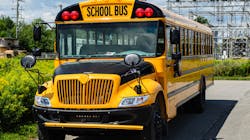Con Edison Test Drives Electric School Buses Toward Improved Reliability, Cleaner Air
Con Edison has begun using the batteries on five electric school buses to provide power to its customers, marking the first time in New York State that electricity has flowed from buses into a utility's grid.
By day, the e-buses from Lion Electric carry students to an elementary school in White Plains. They displace runs by buses that burn diesel, meaning better air quality in the Westchester County community.
Con Edison and its partners have begun sending power from the batteries into its grid, a milestone in a demonstration project Con Edison began in 2018. The five buses can each discharge 10 kW. For the five buses, that's 50 kW or 50,000 W.
That is a small amount of power for a utility grid with the capacity to reliably serve millions of homes and businesses in Westchester County and New York City. But the goal of the project is to explore the technological and economic potential of using e-school buses on a wider scale to improve air quality and grid reliability.
There are approximately 1000 school buses operating in Westchester and 8000 in New York City that could make a significant difference if converted to electric.
"We think e-school buses may provide an opportunity to achieve two of our company's goals, which are reducing carbon emissions and maintaining our industry-leading reliability," said Brian Ross, Con Edison's manager for the project. "We are innovating to help our state and region achieve a clean energy future in which electric vehicles (EVs) will have a big role."
The White Plains school district put the buses on the road for the 2018 to 2019 school year and has found them to be reliable transportation. The company and its partners have since developed solutions to technical challenges, such as coordinating communication between the buses, the chargers, and the batteries.
The charging and discharging takes place at a depot in North White Plains. The buses plug into a charger when the demand for power is low. The chargers reverse the flow of power into the grid at times when the buses are not transporting children.
The buses are manufactured by Lion Electric in North America with vehicle-to-grid (V2G) technology, and operated for the school district by National Express.
"Our operators are dedicated to enabling the success of school bus electrification and V2G for the White Plains school district, with safety and reliability remaining our top priorities," said Charlie Bruce, senior vice president of business development for National Express.
"Our V2G software platform is designed to deliver grid services such as those to Con Edison from e-school buses," said Gregory Poilasne, chairman and CEO of Nuvve Corp. "The e-buses provide a cleaner environment for communities and help lower carbon dioxide (CO2) emissions while ensuring that driving energy needs are met every day."
Nuvve is a San Diego-based, green energy technology company, a leader in V2G, and a partner in the White Plains project. Con Edison contracted with First Priority Group (FPG) to help develop and manage the project.
"Our goal was to bring industry experts together in a collaborative fashion to design and install one of the first true bidirectional V2G solutions in the United States," said Alex Cherepakhov, the FPG's chairman and CEO. "V2G integration is the next step in the evolution of EV fleet power technology and we are pleased to have collaborated with our partners in making this happen."
National Express pays the energy costs during the school year. Con Edison, the New York State Energy Research and Development Authority, and National Express contributed to paying for the buses. Con Edison and National Express paid for the chargers.
The upfront cost of e-school buses is higher than diesel buses. But using e-school buses for V2G purposes could make them more attractive to school districts, the communities they serve, and the bus operators that provide the service.
School schedules match up well with the power needs of Con Edison's 3.5 million customers. School buses are generally idle during the summer, which is when utility customers' need for power rises because of air conditioning. Discharging power from the buses into the grid at these times of high demand would take stress off Con Edison electric-distribution equipment.
Among the questions the project will answer is whether the frequent charging and discharging will speed the degradation of the batteries.
